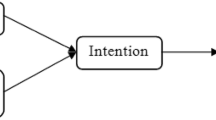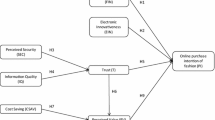Abstract
The Internet of Things (IoT) is a paradigm of connectivity and networks for devices with electronics, sensors, and software connected to cyberphysical systems anytime and anywhere. As an innovation, the IoT aids consumers in multiple ways in the retail sector, satisfying utilitarian and hedonic shopping motivations, and as a result, exploring their shopping motivation is necessary. This study deploys the unified theory of acceptance and use of technology (UTAUT) embedded in perceived enjoyment, trust, and risk to estimate Malaysian consumers’ attitude toward the IoT for online fashion shopping, eventually leading to utilitarian and hedonic shopping motivations. Quantitative survey data collected from Malaysian IoT shoppers were analyzed using partial least squares structural equation modeling. The outcomes revealed that IoT performance expectancy, effort expectancy, facilitating conditions, and perceived enjoyment significantly and positively affected attitude toward the IoT. However, the impact of social influence, perceived risk, and perceived trust on attitudes toward the IoT appeared to be insignificant. Attitude toward the IoT significantly influenced utilitarian shopping motivation, followed by value- and adventure-related shopping motivations. This assimilated study model highlights how attitude toward the IoT mediates the relationships among IoT performance expectancy, effort expectancy, facilitating conditions, and perception of enjoyment regarding shopping motivations. The current study adds to the literature by enhancing UTAUT3 and exposing allied shopping motivations toward IoT-facilitated fashion shopping. This study offers practical implications for developing trust and reducing risk to harness positive attitudes toward the IoT to enhance fashion shopping. Related shortcomings and practical implications are outlined at the end of this paper.
Similar content being viewed by others
Data availability
Data will be made available on reasonable request.
References
Akram U, Junaid M, Zafar A, Li Z, Fan M (2021) Online purchase intention in Chinese social commerce platforms: being emotional or rational? J Retail Consum Serv 63:102669. https://doi.org/10.1016/j.jretconser.2021.102669
Alraja MN, Farooque MMJ, Khashab B (2019) The effect of security, privacy, familiarity, and trust on users’ attitudes toward the use of the IoT-based healthcare: the mediation role of risk perception. IEEE Access 7:111341–111354. https://doi.org/10.1109/ACCESS.2019.2904006
Aw E, Kamal Basha N, Ng S, Ho J (2021) Searching online and buying offline: understanding the role of the channel-, consumer-, and product-related factors in determining web rooming intention. J Retail Consum Serv 58:102328. https://doi.org/10.1016/j.jretconser.2020.102328
Balaji MS, Roy SK (2017) Value co-creation with internet of things technology in the retail industry. J Mark Manage 33(1–2):7–31. https://doi.org/10.1080/0267257X.2016.1217914
Ben Arfi W, Ben Nasr I, Khvatova T, Ben Zaied Y (2021) Understanding acceptance of eHealthcare by IoT natives and IoT immigrants: an integrated model of UTAUT, perceived risk, and financial cost. Technol Forecast Social Change. https://doi.org/10.1016/j.techfore.2020.120437
Car T, Stifanich LP, Šimunić M (2019) Internet of things (IoT) in tourism and hospitality: opportunities and challenges. Tour South East Europe 5:163–175. https://doi.org/10.20867/tosee.05.42
Chin WW (2010) How to write up and report PLS analyses. In: Esposito Vinzi V, Chin WW, Henseler J, Wang H (eds) Handbook of partial least squares: concepts, methods and applications. Springer, Berlin, pp 655–690
Chin J, Callaghan V, Ben Allouch S (2019) The internet-of-things: reflections on the past, present and future from a user-centered and smart environment perspective. J Ambient Intell Smart Environ 11(1):45–69. https://doi.org/10.3233/AIS-180506
Cho J (2004) Likelihood to abort an online transaction: influences from cognitive evaluations, attitudes, and behavioral variables. Inform Manage 41(7):827–838. https://doi.org/10.1016/j.im.2003.08.013
Dutot V (2015) Factors influencing Near Field Communication (NFC) adoption: an extended TAM approach. J High Technol Manag Res 26:45–57. https://doi.org/10.1016/j.hitech.2015.04.005
Dwivedi YK, Rana NP, Jeyaraj A, Clement M, Williams MD (2019) Re-examining the Unified Theory of Acceptance and Use of Technology (UTAUT): towards a revised theoretical model. Inform Syst Front 21(3):719–734. https://doi.org/10.1007/s10796-017-9774-y
Faul F, Erdfelder E, Lang A-G, Buchner A (2007) G*Power 3: a flexible statistical power analysis program for the social, behavioral, and biomedical sciences. Behav Res Methods 39(2):175–191. https://doi.org/10.3758/BF03193146
Fernandes E, Semuel H, Adiwijaya M (2020) The Influence of social media advertising on purchase intention through utilitarian and hedonic shopping motivation: a study at beauty care and anti-aging clinic service in Surabaya. Petra Int J Bus Stud 3(1):23–36. https://doi.org/10.9744/ijbs.3.1.23-36
Gao L, Bai X (2014) A unified perspective on the factors influencing consumer acceptance of internet of things technology. Asia Pac J Mark Logist 26(2):211–231. https://doi.org/10.1108/APJML-06-2013-0061
Gubbi J, Buyya R, Marusic S, Palaniswami M (2013) Internet of things (IoT): a vision, architectural elements, and future directions. Futur Gener Comput Syst 29(7):1645–1660. https://doi.org/10.1016/j.future.2013.01.010
Hair JF, Risher JJ, Sarstedt M, Ringle CM (2019) When to use and how to report the results of PLS-SEM. Eur Bus Rev 31(1):2–24. https://doi.org/10.1108/EBR-11-2018-0203
Holdack E, Lurie-Stoyanov K, Fromme HF (2022) The role of perceived enjoyment and perceived informativeness in assessing the acceptance of AR wearables. J Retail Consum Serv. https://doi.org/10.1016/j.jretconser.2020.102259
Kalia P (2017) Does demographics affect purchase frequency in online retail? Int J Online Mark (IJOM) 7(2):42–56. https://doi.org/10.4018/IJOM.2017040103
Kamble SS, Gunasekaran A, Parekh H, Joshi S (2019) Modeling the internet of things adoption barriers in food retail supply chains. J Retail Consum Serv 48:154–168. https://doi.org/10.1016/j.jretconser.2019.02.020
Kang J, Park-Poaps H (2010) Hedonic and utilitarian shopping motivations of fashion leadership. J Fash Mark Manag Int J 14(2):312–328. https://doi.org/10.1108/13612021011046138
Karahoca A, Aksöz M, Karahoca D (2018) Examining intention to adopt to the internet of things in healthcare technology products. Kybernetes 47(4):742–770. https://doi.org/10.1108/K-02-2017-0045
Krotov V (2017) The internet of things and new business opportunities. Bus Horiz 60(6):831–841. https://doi.org/10.1016/j.bushor.2017.07.009
Ladhari R, Gonthier J, Lajante M (2019) Generation Y and online fashion shopping: orientations and profiles. J Retail Consum Serv 48:113–121. https://doi.org/10.1016/j.jretconser.2019.02.003
Li L, Wang XF, Lei X (2013) The design of railway information system integration based on IOT. Adv Mater Res 694–697:3336–3339. https://doi.org/10.4028/www.scientific.net/AMR.694-697.3336
Malaysian Communication and Multimedia Commission (2017) Internet user survey, 2016. Malaysian Communications and Multimedia Commission, Putrajaya
Park J, Ha S (2016) Co-creation of service recovery: utilitarian and hedonic value and post-recovery responses. J Retail Consum Serv 28:310–316. https://doi.org/10.1016/j.jretconser.2015.01.003
Parker Cj, Wang H (2016) Examining hedonic and utilitarian motivations for m-commerce fashion retail app engagement. J Fash Mark Manage 20(4):487–506. https://doi.org/10.1108/JFMM-02-2016-0015
Parker Cj, Wenyu L (2019) What influences Chinese fashion retail? Shopping motivations, demographics and spending. J Fash Mark Manage 23(2):158–175. https://doi.org/10.1108/JFMM-09-2017-0093
Patil K (2016) Retail adoption of internet of things: applying TAM model. 2016 Int Conf Comput Analytics Secur Trends (CAST). https://doi.org/10.1109/CAST.2016.7915003
Pinochet LHC, Lopes EL, Srulzon CHF, Onusic LM (2018) The influence of the attributes of ‘Internet of things products on functional and emotional experiences of purchase intention. Innov Manage Rev 15(3):303–320. https://doi.org/10.1108/INMR-05-2018-0028
Podsakoff PM, MacKenzie SB, Lee J-Y, Podsakoff NP (2003) Common method biases in behavioral research: a critical review of the literature and recommended remedies. J Appl Psychol 88(5):879. https://doi.org/10.1037/0021-9010.88.5.879
Sethi P, Sarangi SR (2017) Internet of things: architectures, protocols, and applications. J Electr Comput Eng 2017:e9324035. https://doi.org/10.1155/2017/9324035
Slade EL, Dwivedi YK, Piercy NC, Williams MD (2015) Modeling consumers’ adoption intentions of remote mobile payments in the United Kingdom: extending UTAUT with innovativeness, risk, and trust. Psychol Mark 32(8):860–873. https://doi.org/10.1002/mar.20823
Soni M, Jain K, Kumar B (2019) Factors affecting the adoption of fashion mobile shopping applications. J Glob Fash Mark 10(4):358–376. https://doi.org/10.1080/20932685.2019.1649165
Sujood SH, Naseem Bano (2021) Behavioral intention of travelling in the period of COVID-19: an application of the theory of planned behavior (TPB) and perceived risk. Int J Tour Cit 8(2):357–378. https://doi.org/10.1108/IJTC-09-2020-0183
Thakur R, Srivastava M (2014) Adoption readiness, personal innovativeness, perceived risk and usage intention across customer groups for mobile payment services in India. Internet Res 24(3):369–392. https://doi.org/10.1108/IntR-12-2012-0244
Tyrvainen O, Karjaluoto H, Saarijärvi H (2020) Personalization and hedonic motivation in creating customer experiences and loyalty in omnichannel retail. J Retail Consum Serv. https://doi.org/10.1016/j.jretconser.2020.102233
Venkatesh V, Davis FD (2000) A theoretical extension of the technology acceptance model: four longitudinal field studies. Manage Sci 46(2):186–204
Venkatesh V, Morris MG, Davis GB, Davis FD (2003) User acceptance of information technology: toward a unified view. MIS Q 27(3):425–478. https://doi.org/10.2307/30036540
Venkatesh V, Thong JYL, Xu X (2012) Consumer acceptance and use of information technology: extending the unified theory of acceptance and use of technology. MIS Q 36(1):157–178. https://doi.org/10.2307/41410412
Waheed A, Zhang Q, Farrukh M, Khan SZ (2021) Effect of mobile social apps on consumer’s purchase attitude: role of trust and technological factors in developing nations. SAGE Open. https://doi.org/10.1177/21582440211006714
Wang H, Lee K (2020) Getting in the flow together: the role of social presence, perceived enjoyment and concentration on sustainable use intention of mobile social network game. Sustain (2071–1050) 12(17):6853. https://doi.org/10.3390/su12176853
Wu J, Liu D (2007) The effects of trust and enjoyment on the intention to play online games. J Electron Commer Res 8(2):128–140
Yang M, Mamun A, Mohiuddin M, Nawi N, Zainol N (2021) Cashless transactions: a study on intention and adoption of e-Wallets. Sustainability 13(2):831. https://doi.org/10.3390/su13020831
Yang Q, Al Mamun A, Hayat N, Md. Salleh M, Salameh A, Makhbul Z (2022a) Predicting the mass adoption of eDoctor apps during COVID-19 in China using hybrid SEM-neural network analysis. Front Public Health. https://doi.org/10.3389/fpubh.2022.889410
Yang Q, Al Mamun A, Hayat N, Jingzu G, Hoque M, Salameh A (2022b) Modeling the intention and adoption of wearable fitness devices: a study using SEM-PLS analysis. Front Public Health. https://doi.org/10.3389/fpubh.2022.918989
Yoon S-J (2002) The antecedents and consequences of trust in online-purchase decisions. J Interact Mark 16(2):47–63. https://doi.org/10.1002/dir.10008
Funding
This research was supported by Ministry of Higher Education, Malaysia (Grant FRGS/1/2019/SS01/UMK/02/2).
Author information
Authors and Affiliations
Corresponding author
Ethics declarations
Conflict of interest
The authors declare no conflicts of interest.
Additional information
Publisher’s Note
Springer Nature remains neutral with regard to jurisdictional claims in published maps and institutional affiliations.
Electronic supplementary material
Below is the link to the electronic supplementary material.
Rights and permissions
Springer Nature or its licensor (e.g. a society or other partner) holds exclusive rights to this article under a publishing agreement with the author(s) or other rightsholder(s); author self-archiving of the accepted manuscript version of this article is solely governed by the terms of such publishing agreement and applicable law.
About this article
Cite this article
Nawi, N.B.C., Mamun, A.A., Hayat, N. et al. Attitude of Fashion consumers toward the IoT: estimating consumer hedonic and utilitarian shopping motivations. J Ambient Intell Human Comput 15, 751–763 (2024). https://doi.org/10.1007/s12652-023-04733-3
Received:
Accepted:
Published:
Issue Date:
DOI: https://doi.org/10.1007/s12652-023-04733-3




